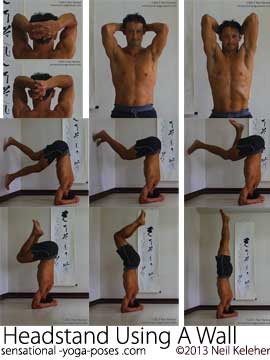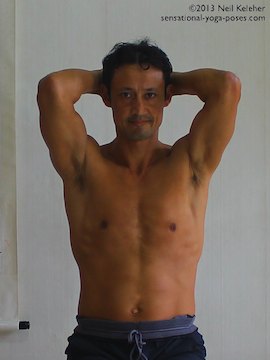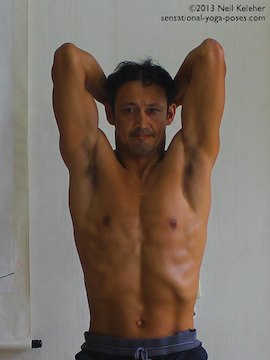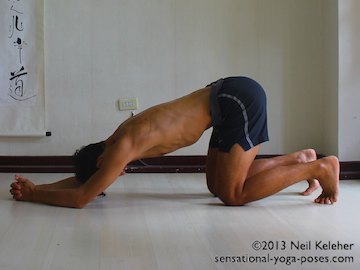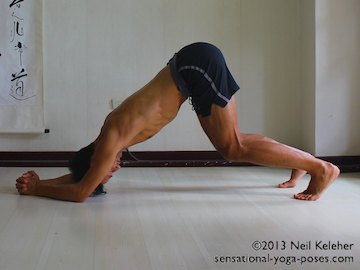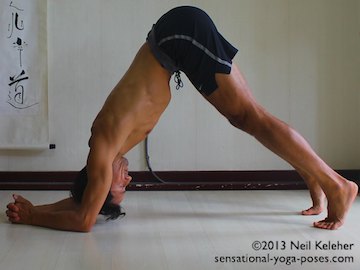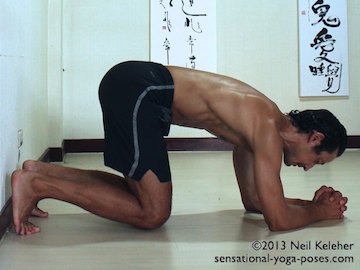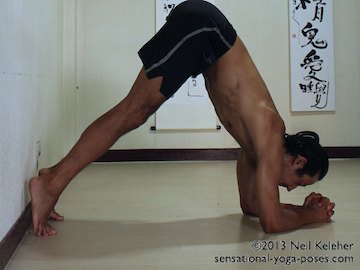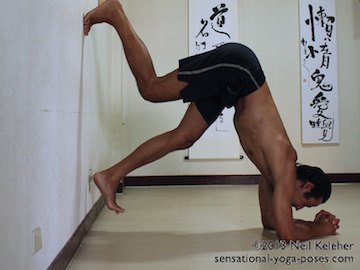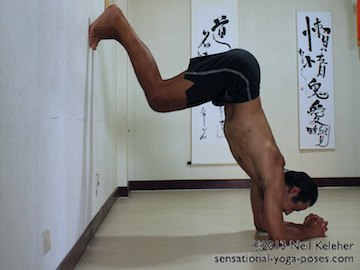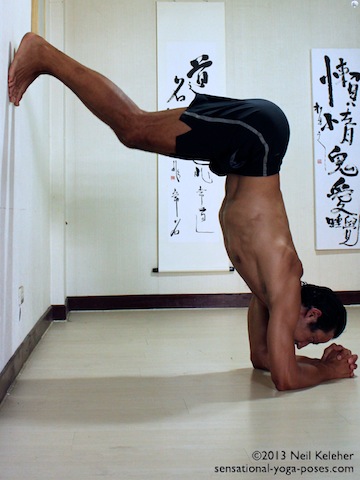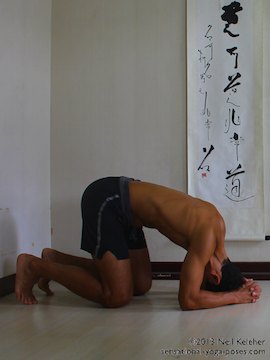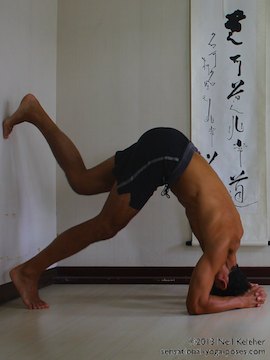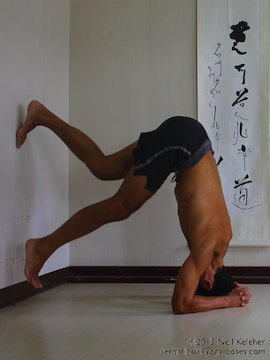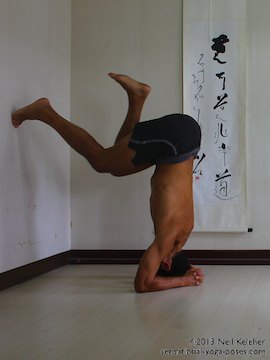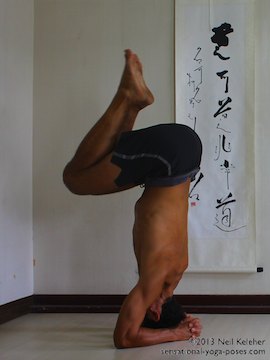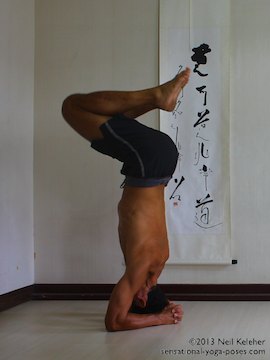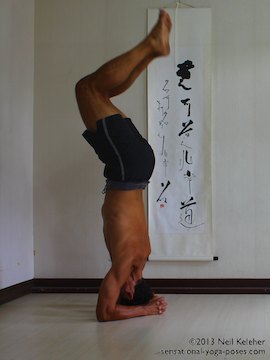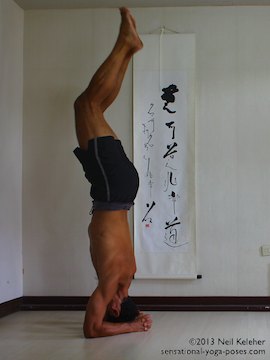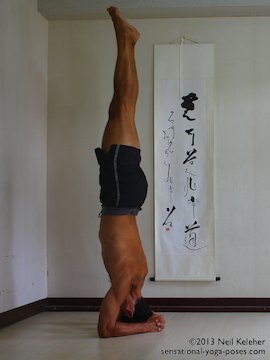Get Used to Being Upside Down
Learning Headstand using a wall is one of the easier ways to get used to being upside down.
Because you can use the wall to get your feet up, there is less of a flexibility requirement. Because using a wall makes it easier to get the legs up it is then easier to focus more awareness on the neck and shoulders so that it is easier to keep the neck safe.
Learning headstand using a wall not only gives control, it gives confidence and comfort.
It can also be used to gradually move into balance.
Learn Your Neck and Shoulders Prior to Doing Bound Headstand Using a Wall
In Bound Headstand we potentially bear the weight of most of body on our neck. (In Tripod Headstand we do bear most of our body weight on the neck.) So it is important to be aware of you neck and to make it stable prior to going into headstand. Since the neck rests on the ribcage, ribcage awareness is also important.
Neck and Chest Awareness
Practice lifting your chest while at the same time pulling your head back and up. Keep your head level as you do so. This can be done as a breathing exercise initially. Then practice keeping your ribcage open with your neck long while breathing into your upper belly.
(For more on breathing with ribcage and neck awareness
check out the thoracic mobility or the having a hard time breathing articles.)
Callibrating for Side Lean
Once you are used to feeling your neck you can then calibrate your awareness of side-to-side neck lean.
While sitting in front of a mirror with chest lifted and neck long, slowly bend your neck to the left and then to the right. Close your eyes and make both sides of your neck feel equally long. Make both sides of your ribcage feel equally open.
Open your eyes and use the mirror to see if your neck is actually straight from side to side. If not then repeat the exercise until you can feel when your neck is straight.
To get used to feeling your neck straight with weight, try it with torso horizontal while leaning the top of your head into a wall. You can have your hands on the wall too, use your hands help bear some of your body weight.
Using the Shoulders and Neck
With neck long and chest lift and arms down practice lifting and lowering your shoulders. Once you can do this slowly and smoothly and without thinking, do the same exercise with arms lifted straight up. Lift and lower your shoulders while keeping your arms raised.
Then try the same exercise with elbows bent and hands clasped behind the head.
(These exercises and more are shown on the scapular awareness page).
Clasping the Hands
Note that there are two ways to clasp your hands for headstand. One is with the palms together, the other is with the palms open. In either case tuck the bottom little finger inside so that the outsides of both hands can press into the floor. And in both cases keep the hands and forearms strong.
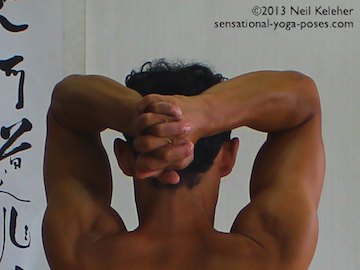
Palms together.
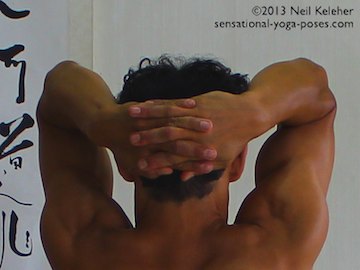
Palms apart.
Practice both options.
First with palms together make your hands and wrists strong. Use your shoulders to push your elbows up and then relax. Repeat.
Then try with palms cupping and pressing the sides of the head. Again make your hands strong. Press elbows up and then relax. Repeat until you can do the movement without having to think.
Also practice switching the interlace of your fingers so that you your left pinky is lowermost and then your right (or vice versa.) When doing Bound Headstand using a wall regularly, practice with one hand lowermost and then the other.
Body Weighted Shoulder Work
Prior to going up using the wall, practice using your shoulders while they are supporting your body weight. You can do this first in downward dog pose with the knees bent.
Another option is to
press your head and elbows into a wall with torso horizontal.
Then try it with bent elbows and hands clasped and forearms on the floor. This is similar to dolphin pose except that pose is normally taught with the hands apart and forearms parallel. With elbows straight (downward dog) then bent, practice using your shoulders to push your ribcage back away from your elbows (or hands.)
To add more weight to your shoulders use your legs to push your pelvis forwards and up. But keep your shoulders active as you do so. Use your shoulders to keep pushing your ribcage away from your elbows.
Bound Headstand Safety (Fall Safely)
Prior to doing Bound Headstand using a wall make sure your wall is clear of all obstacles and that the area in front of the wall is clear of anything that might hurt should you fall.
How to Prepare for Headstand Using a Wall
(With Head off of the Floor)
Now we can work on this same pose but with the feet against the wall.
Exercise 1
Rather than rushing the idea is to get used to this Headstand using a wall preparation in stages. Rather than holding this position simply practice going up and coming down without holding to begin with.
Make hands strong.
Press elbows Down.
Lift one leg, press it into the wall.
Lift the other leg an inch off of the floor.
Pause then lower and repeat alternating legs each time.
Exercise 2
For the next exercise, lift the other leg all the way up and place it on the wall beside the first leg. Then come down.
Repeat a few times switching lead leg each time. You can also swtitch the interlace of your fingers.
Exercise 3
Next stay up with both feet on the wall. Use your legs to push your pelvis away from the wall a little bit, then bring the pelvis close to the wall. I'd suggest repeat once or twice, come down, rest for a bit, then go back up and repeat.
Depending on how close you are to the wall you may or may not be able to straighten your knees. That isn't the goal. Rather it is to use your legs to move your pelvis away from the wall a little bit and then closer. Do this slowly so that you can feel if you are going to push your self of balance. Stop before you do so.
Practice Rolling Prior to Bound Headstand Using a Wall
Prior to trying to balance in Bound Headstand using a wall, practice doing a forward roll so that in case you go too far you can roll out safely and without fear.
How to Do Headstand Using a Wall
The next step is to repeat using the wall but with your head on the floor.
With your head on the floor, the job of the shoulders is to control the amount that the elbows press into the floor.
Set Up and Exercise 1
With crown of your head on the floor clasp hands behind the head with bottom pinky tucked in.
Press your head down and open your chest. Reach it towards your chin!
Press shoulders into the floor. Lift your hips and adjust head for neck comfort.
Place one foot on the wall, slowly press, then lift the other foot. Lower. If neck is uncomfortable, come down and re-adjust. Repeat.
Repeat a few times alternating legs each time.
Exercise 2
Rest and then repeat the exercise but place both feet on the wall at hip height.
Use your legs to slowly push your pelvis away from the wall and then bend the knees so that your pelvis can come close to the wall.
Keep pressing your elbows into the floor and notice the shift in pressure as you move your pelvis back and forwards.
- You may notice that your elbows press down more when your pelvis is closer to the wall.
- You may notice the pressure shifting towards your head when your pelvis is further away from the wall.
If you notice the pressure moving past your head you've gone too far and will roll out. So stop before you get there.
Maintaining Control
While Doing Headstand Using a Wall
The idea of going up and down is to get used to moving into Bound Headstand using a wall with control. And also to help you get used to keeping your shoulders and neck strong and stable.
You can next work at doing headstand with your your base closer to the wall. As you practice closer to the wall you can then use your legs to push your pelvis away from the wall. Depending on how close you are you won't be able to straighten your legs. But that's not the goal. Instead it is to find your balance point. So as you press your hips away from the wall using your feet look for the position where your elbows and head press down with equal pressure.
And pay attention to the way that your feet press into the wall. That too will give you a hint as to when your weight is over your head and elbows.
How to Get Your Feet off of the Wall
To get your feet off of the wall in headstand, the easiest method is to scissor the legs while keeping the knees bent.
Move one foot off of the wall. Move the knee towards your chest while feeling your other foot. As you other foot becomes "light" on the wall (empty) then pull it off of the wall and bring your legs together.
Rather than going up into Bound Headstand I'd suggest returning the wall and then coming down. Then go back up and see if you can again pull both feet off of the wall smoothly by scissoring.
Once you can do that consistently, then work at lifting your legs higher.
Go up a bit then come down, repeat. And gradually go higher.
How to Do Lift Your Legs
If you can get your feet off of the wall you can then work at reaching your legs up. Keep your weight even between elbows and crown of your head.
Start by bending your knees and bringing them close to your chest. Hold here for a few moments with weight centered between elbows and head. Then lift your knees keeping them bent. Then straighten your legs vertically.
If you keep your center positioned so that your elbows and head press down with equal pressure your Bound Headstand may have a slight forward lean. For a vertical Bound Headstand with the body straight, you can shift your weight so that it is centered on your head. But I'd suggest working towards this gradually.
For now, while balancing in Bound Headstand focus on keeping your weight between elbows and head. To come down, reverse the process using the wall to help get your feet to the floor. Rest.
If you want to learn
how to lift up into headstand with legs straight
read How to Do Headstand with Legs Straight.
How to Recover from Headstand
Normally the recommended counterpose for Bound Headstand is Shoulderstand. So after doing Bound Headstand using a wall you could then do Shoulderstand using a wall.
I'd suggest that you could also do a standing forward bend focusing on letting your head hang so that your neck can lengthen.
Since in Bound Headstand your arms are "forwards and up" a counterpose for the shoulders could be bending forwards with hands behind the back, or kneeling with hands clasped and reaching back and up.
Or do table top or reverse plank.
Published: 2011 04 05
